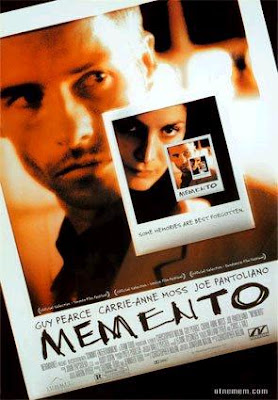
If you haven't seen memento yet, stop reading this article right now, and go see it.What are you doing online when you could be seeing uber cool movies anyway?Memento is a story about a person (Leonard, played by Guy Pearce) with anterograde amnesia. He remembers stuff, he just cant make new memories after the point of time in his life where he was hit on the head by the man who murdered his wife. So the last memory, fresh in his mind, every morning when he wakes up is the sight of his wife dying. Waking up with that thought leaves him with a vengance and a hunger to find his wife's killer that he cant erase ("how can i heal if i cant feel time?"). So in spite of his disablility, he decides to hunt down the killer, with the aid of the facts of his case tatooed all over his body, and pictures of people and places so he doesnt forget them.
The brilliant part about memento is the fact that the story is told backwards... The first scene is the one where he kills the man he was looking for (a man named John G.) and then proceeds to show how he tracked him down (which is the only scene that is actually in reverse, as in a photograph of a dead man undevelops, Leonard takes the picture, the bullet flies out of the dead man's head and back into the gun, and he springs back to life briefly before the first black and white sequence kicks in). In effect, that leaves the viewer with the same span of memory as Leonard, as every time he wakes up, we dont know what has happened before that day/moment, and have as much prior knowledge to the situation as Leonard does, which sometimes leads to funny twists and turns which do well to take us away from the films darker motifs.
Each segment that is in color is actually in reverse chronological order, interspersed with a black and white sequence that is chronological and presents the beginning of the film. The films color sequences eventually work their way backwards and at the end of the film meet the final black and white sequence that blends beautifully into color as a polaroid photograph taken by Leonard develops.
Memento has probably the best style and treatment a film has recieved to put the audience in the shoes of someone with anterograde amnesia, by being as nonplussed throught the entire movie, until the end when all the pieces come together. And when the pieces do start to fit, they unearth a puzzle much deeper and unsettling than is first apparent. Nolan uses a layer of deeper meaning in the form of clues for the audience to see (but mostly tend to miss) in the form of certain dialogues that dont seem to fit "my wife called me lenny.. i hated it" and in micro second flashes of certain things that dont seem to fit in with the rest of the scene. There are so many subtle touches that this film is so full of, that this is one movie that will really be... hard to forget.

No comments:
Post a Comment